Epipremnum pinnatum is easy to care for, according to the University of Florida.
The plant showcases glossy green leaves and supporting vines, often requiring fences or trellises to maintain its climbing habit.
The Epipremnum Pinnatum plant makes an excellent indoor plant with leaves measuring three inches. Let’s learn more about this beauty.
Epipremnum pinnatum Care
The Epipremnum pinnatum plant enjoys bright, dappled sunlight, weekly watering, moderate moisture, and temperatures between 65° F and 75° F (18° C to 24° C). It likes plenty of organic matter in its soil and should be pruned yearly to keep it looking healthy and fresh. Fertilize every two weeks in spring and summer. A humidity level between 50-70% is fine.

Epipremnum Pinnatum Plant Care
Table of Contents
Caring for an Epipremnum pinnatum
Epipremnum pinnatum soil mix
The Epipremnum Pinnatum plant is not too particular about its soil.
However, please plant it in well-draining, fertile soils for best growth.
The Epipremnum Pinnatum plant enjoys plenty of moisture; therefore, adding organic materials like coco coir or perlite will speed growth.
The Epipremnum Pinnatum plant enjoys natural substrates, so its favorites are light and organic soil ingredients.
Please avoid mucky, damp, sandy, and dry soils, as the vines do not react well.
How to Water Epipremnum pinnatum
The best time to water your wonderful Epipremnum Pinnatum plant is when its soil dries about 1 to 2 inches.
Fill a bucket with chlorine-free, lukewarm water and let it sit overnight. If you have distilled water, you must make up for it by adding some micronutrients in fertilizer.
Add the water the next day, ensuring you go all around the soil, leaving no spot dry.
The ideal watering frequency in the growing season is once a week, while once, two to three weeks is fine during the dormant seasons.
Please ensure that you water the plant before the soil begins cracking. Similarly, use room-temperature water to avoid shock.
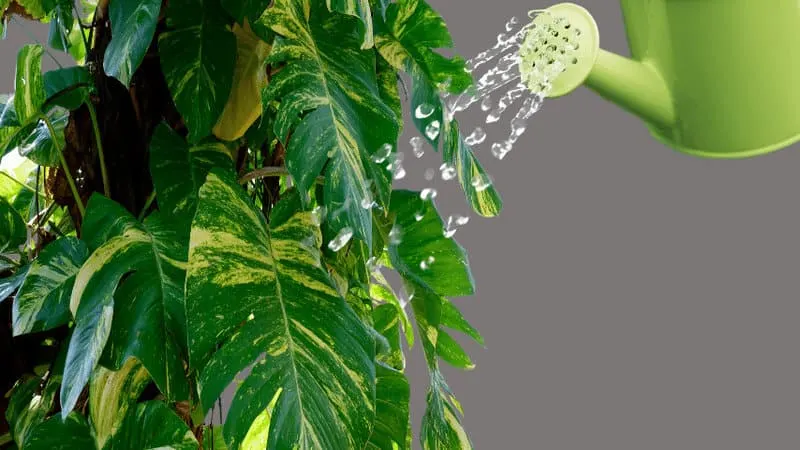
The best time to water your Epipremnum pinnatum plant is when its soil becomes dry
Epipremnum pinnatum Light
Almost all the plants from the Araceae family rely on sunlight to maintain their beautiful characteristic colors.
The same applies to the Epipremnum Pinnatum plant, which enjoys bright, indirect sunlight.
Please place it in front of the northeast or south-facing window for the most colorful and healthiest foliage.
If left in the harsh sunlight for too long, such as the afternoon sun,
the Epipremnum Pinnatum plants undergo leaf scorching, or the leaves curl to reduce their surface area.
For cloudy areas, artificial growing lights can be used to develop the Epipremnum Pinnatum plant.
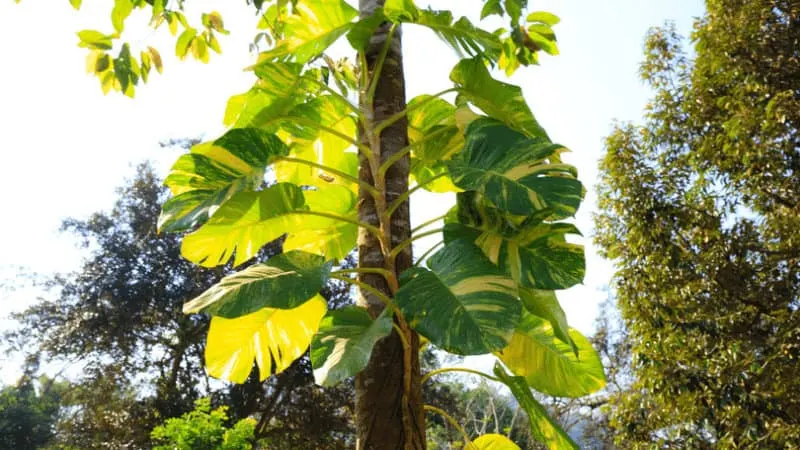
Epipremnum Pinnatum plant, which enjoys bright, indirect sunlight to maintain their beautiful characteristic colors
Temperature
The Epipremnum Pinnatum plant manages quite well in a wide range of temperatures.
However, the ideal range lies between 65° F and 75° F degrees (18° C to 24° C).
This temperature range keeps the plant relatively warm while saving it from overheating.
In colder areas, the Epipremnum Pinnatum plant must be kept warm.
Bring it indoors during the colder days but keep it safe from heating vents.
In contrast, please keep it in a cool area on hotter days to prevent overheating.
Humidity
Provide humidity levels between 40% to 70%.
A great benefit of growing the Epipremnum Pinnatum plant is that it adjusts to a wide range of humidity, from low to high.
But for optimal growth, keeping the plant in its desired moisture range is necessary.
The average household humidity of 50% to 60% is ideal, so bring it indoors or take it outdoors; it will adjust pretty well to both.
Fertilize Epipremnum pinnatum
Fertilize every two weeks in spring and summer using a liquid fertilizer.
Repotting
Repot your Epipremnum pinnatum plant right before the summer season.
Choose a pot with a diameter of at least 10 inches larger than the previous one.
You can also refresh the soil’s ingredients using organic materials like sphagnum moss or coco coir.
The idea is to transfer the Epipremnum Pinnatum plant into a large pot
to allow full growth without compressing the roots or compromising the vines’ length.
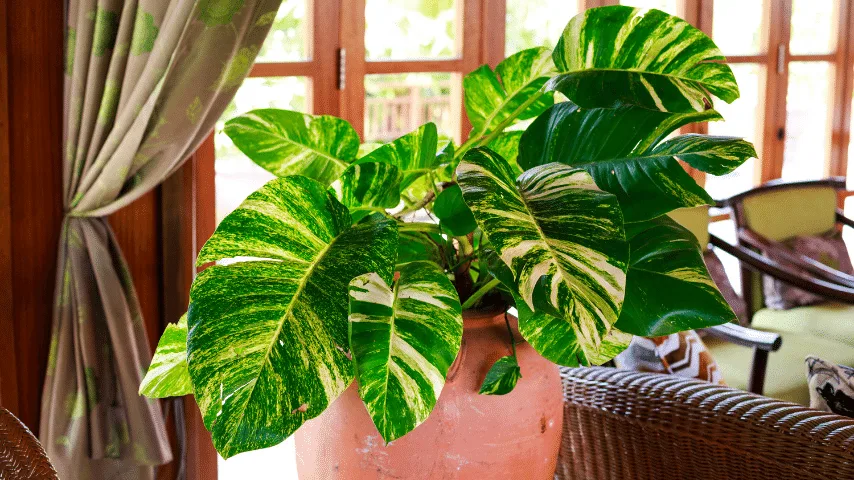
Repot your Epipremnum Pinnatum plant right before the summer season
Pruning
The Epipremnum Pinnatum plant thrives in indoor pots and patios.
It does not require frequent pruning but needs it occasionally to maintain its freshness.
Trimming off diseased and old foliage also saves the Epipremnum Pinnatum plant a lot of energy, allowing it to spend this energy on new growth.
Prune the Epipremnum Pinnatum plant using a sterilized knife or pruning tool. Clean the pruning tool with plant-based alcohol.
If you use infected pruning tools, the plant will likely catch fungal infections.
Therefore, please ensure you clean the tools before each pruning session.
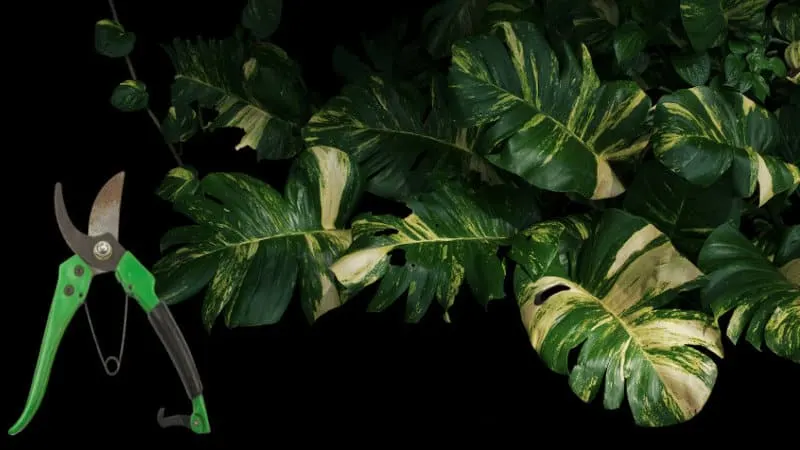
Prune the Epipremnum Pinnatum plant using a sterilized knife or pruning tool
Epipremnum pinnatum Propagation
It is pretty easy to fall in great love with a plant as beautiful as the Epipremnum pinnatum.
The best way to celebrate your love is to share this excellent climber with friends and family.
Propagate it via the following method, but be sure to do this in the summer or spring season only:
- Pick a healthy plant and split the stems into half, laying each on the bottom of a glass half-full of water.
- Next, take the cutting and check if it has a minimum of one tied knot while inside the water since this is where the roots will sprout.
- Supply the tiny cuttings with clean and warm propagation media so they root faster.
- Place the water bottles in a temperate environment.
- When you notice some roots, take out the cuttings.
- You can now plant the cuttings in a garden or a container with a suitable soil mix.
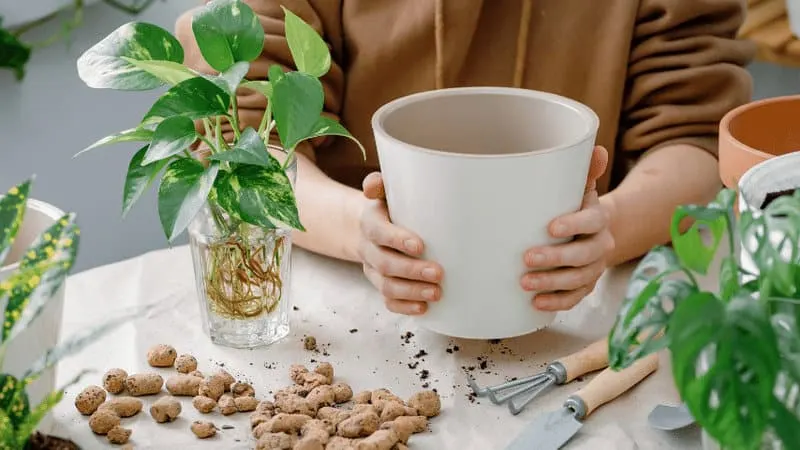
Epipremnum Pinnatum plant propagation is pretty easy
Blooms
The Epipremnum Pinnatum plant is grown primarily for its lovely foliage.
Only some types give rise to blooms, but they are unimportant.
Growth
The Epipremnum Pinnatum plant grows best in USDA zone 11.
The ideal patio or terrace zone is 4-b to 11, with a warm, moist environment.
Epipremnum pinnatum variegated care
Epipremnum pinnatum albo variegata care is similar to the care of Epipremnum pinnatum. The main difference is that it needs more light. Variegated plants have increased lighting needs. Therefore provide the higher end of bright indirect light.
A well-lit eastern-facing or western-facing window is ideal. A temperature between 65° F and 75° F (18° C to 24° C), as well as 50-70% humidity, is optimal. Water once a week and fertilize twice a month. Use well-draining organic soil.
Common Problems for Epipremnum Pinnatum
Plant Pests
You can keep your plant in any corner; pests will always find it and remove its nutrients.
The Epipremnum Pinnatum plant’s most frequent attackers include spider mites and mealybugs.
Spider mites are small, eight-legged creatures that suck all the sap from a plant.
They can cause significant damage, harming existing growth, limiting new growth, and causing wilting in severe cases.
As their numbers increase, the spider mites cause the formation of yellow spots and dry the entire plant.
Mealybugs do not cause any less harm. These tiny, soft-bodied pests cover the Epipremnum Pinnatum plant with sticky, waxy honeydew.
As this substance spreads, it causes mold to grow on the leaves.
Use horticultural oil like neem oil or insecticidal soap to eliminate these tiny but powerful pests.
Ensure you apply it to all the affected parts and keep the plant separately until it fully recovers.
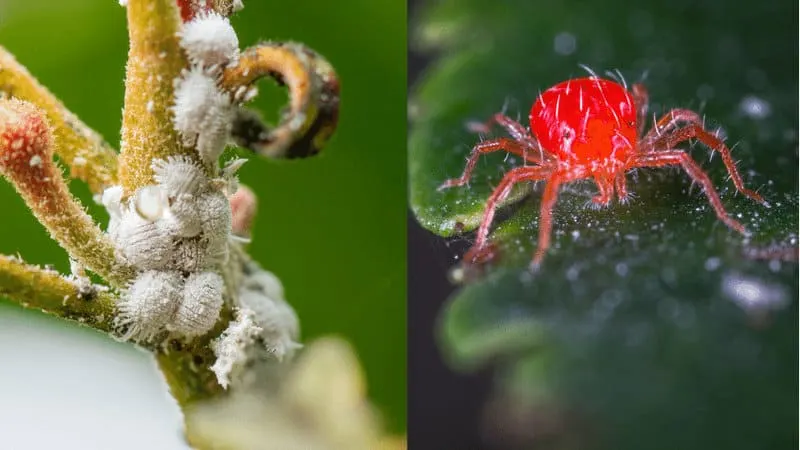
Epipremnum Pinnatum plant’s most frequent attackers include spider mites and mealybugs
Leaf Spotting
These small spots form all over the leaves, often due to fungal infections, bacterial infestations, and nematodes.
The plant undergoes severe damage as the causative agents multiply, leaving the plant dry and completely depleted of nutrients.
To reduce their number, ensure that each new plant you bring is infection-free and well-maintained.
Inspect the new plants closely before putting them next to your Epipremnum Pinnatum plant.
Moreover, maintain good hygiene, remove weeds, and occasionally apply neem oil on the plant.
Alternatively, use insecticides or pick off the larger nematodes manually.
Fungal Infections
One of the most typical fungal infections the Epipremnum Pinnatum plant suffers from is Rhizoctonia infection.
It is a fungal disease that causes dark, irregular, and necrotic spots in various places.
It can be transmitted from surrounding infected plants or be introduced through other means, such as contaminated water.
The fungus causes leaves to stick together, sometimes making the fungal strands reasonably visible.
If left untreated, the Rhizoctonia fungus takes over, especially during propagation. The plant wilts, turn dark brown, and eventually die.
To prevent this, keep your Epipremnum Pinnatum plant well away from infected plants or other sources.
Treat infected plants with a fungicide and use sterilized equipment when propagating the Epipremnum Pinnatum plant.
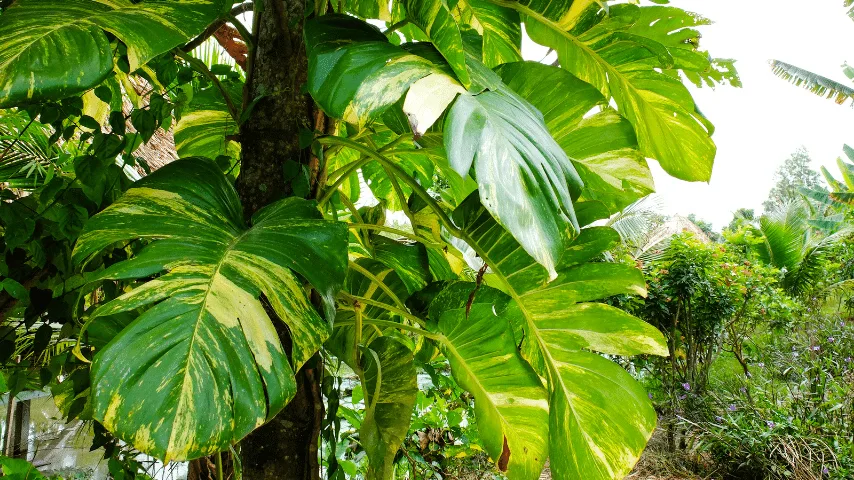
The Epipremnum pinnatum plant has lovely leaves. Any disease that affects its leaves completely ruins its aesthetic value
Tips for Growing Epipremnum pinnatum
- The Epipremnum Pinnatum plant grows best in bright, indirect sunlight. Indoors, southeast, and northeast-facing windows do wonders in terms of lighting for this plant.
- Use a chunky mix of soil for the Epipremnum Pinnatum plant.
- Add organic matter, such as coco coir and perlite. Add organic matter every few months to keep the soil fresh and moist.
- Do not water the soil more than required. Add water only when the Epipremnum Pinnatum plant’s soil top few inches seems dry or the leaves appear slightly wrinkled.
- Maintain a temperature range of 65º F to 80º F (18º C to 27º C).
- Keep the Epipremnum Pinnatum plant in indirect sunlight for at least six hours daily, ensuring you move it to a shady spot in the afternoon.
Frequently Asked Questions
Is the Epipremnum Pinnatum an indoor plant?
The Epipremnum Pinnatum plant can adapt considerably to indoor and outdoor conditions.
It adjusts to various humidity and light levels, still giving off fresh green leaves.
However, it may be slightly picky in an arid environment since it enjoys medium to high moisture.
You can make use of a humidifier to help it grow.
How often should I water my Epipremnum Pinnatum plant if I grow it indoors?
The Epipremnum Pinnatum plant is ideal for forgetful caretakers since it does not need a lot of water.
Most Epipremnum Pinnatum plants grow exceptionally well, just once a week watering.
Excess water may cause root rot and other fungal infections. Therefore, please avoid it.
Is the Epipremnum Pinnatum a climbing plant?
The Epipremnum Pinnatum plant is from the climbing species.
It belongs to the Araceae family, showcasing cordate leaves, which take up a pinnatifid shape as they mature.
Why is my Epipremnum Pinnatum plant growing so slowly?
There can be several reasons why your Epipremnum Pinnatum plant is growing slower than usual.
Unless it is a dormant season, slow growth is an alarming sign.
Please place it in medium indirect sunlight and moderate humidity and give it enough space to spread out.
What is the difference between the Epipremnum Pinnatum plant and Cebu blue plant?
The Epipremnum Pinnatum plant is called Pothos, boasting large leaves with a deep green shade.
On the other hand, the Cebu blue plant has smaller foliage colored bright light blue. Ask your local plant salesman for more details.
Conclusion On Epipremnum pinnatum Care
To care for Epipremnum pinnatum provide bright indirect light. Water once a week. Provide temperatures between 65°-75° F (18° C to 24° C). Use well-draining soil. Fertilize bi-weekly in the main growing seasons. Provide a humidity between 50-70%.


